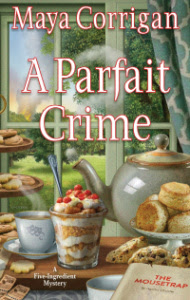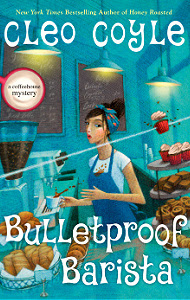by Sheila Connolly
You suffered through my fresh-fruit-and-veg rant last week; this week you get my fish rant. Don’t worry—I’ll get it out of my system soon. Maybe. (Don’t even get me started on high-fructose corn syrup.)
I live in southeastern Massachusetts, no more than fifteen miles from open water, as the crow flies. You remember—Massachusetts is on a coast? So why can’t I get fresh fish around here?
At my local supermarket, I peruse the fish section weekly. I like fish, both to eat and to cook. But not if it’s been flown from Norway or Indonesia (see last week’s rant). Of the ten or so varieties the market offers week to week, only occasionally is one fresh. Yes, I know that many of our oceans have been overfished, so I accept that many of the fish have been flash-frozen on a far-distant ship and then delivered to our markets, where they are thawed (note: I recently bought some perfectly lovely flounder that had endured that process, and while it tasted fine, it disintegrated into mush when I tried to cook it).
 A couple of years ago I found a French fish poacher at a yard sale, where it was classified as a tool box. I paid five dollars for it, then went hunting for a whole fish to cook. No dice. Yes, we have a “real” fish market in town, but the fishmonger had no whole fish. His suggestion? Go to Sandwich, on Cape Cod, and stand on the dock waiting for the fishing boats to come in.
A couple of years ago I found a French fish poacher at a yard sale, where it was classified as a tool box. I paid five dollars for it, then went hunting for a whole fish to cook. No dice. Yes, we have a “real” fish market in town, but the fishmonger had no whole fish. His suggestion? Go to Sandwich, on Cape Cod, and stand on the dock waiting for the fishing boats to come in. In June we spent a night in Galilee, Rhode Island, courtesy of my daughter, who had a couple of nights left on a shared rental (and was actually willing to invite her parents!). Galilee is tiny, and it’s an honest fishing town. It has lots of serious fishing boats that go in and out daily. And (sound of trumpets) it has a fish market, mere feet from the water. And I fell in love with a piece of monkfish.
In June we spent a night in Galilee, Rhode Island, courtesy of my daughter, who had a couple of nights left on a shared rental (and was actually willing to invite her parents!). Galilee is tiny, and it’s an honest fishing town. It has lots of serious fishing boats that go in and out daily. And (sound of trumpets) it has a fish market, mere feet from the water. And I fell in love with a piece of monkfish. I first encountered monkfish on an old Julia Child French Chef episode, where she started by hauling one of the critters onto a chopping block. Those things can be big! The strange thing is, you don’t eat most of it, just the tail (although I’m told that some chefs enjoy the liver). The rest you throw away.
I first encountered monkfish on an old Julia Child French Chef episode, where she started by hauling one of the critters onto a chopping block. Those things can be big! The strange thing is, you don’t eat most of it, just the tail (although I’m told that some chefs enjoy the liver). The rest you throw away.If you’ve never eaten monkfish, you’re in for a treat. It’s firm and white, with a texture much like lobster, and a bit of the same sweet flavor. The first time I ate it was in a small pub in Ireland, believe it or not (although they are surrounded by water, the Irish have never been much into eating fish, even during the Great Famine), with one harried woman cook, kids running around, and a drunk sleeping on the bar. I ordered the monkfish (with a tarragon cream sauce) and was astonished: it was wonderful.
Of course, if you want to try to cook monkfish at home, you have to find monkfish, which is not easy. Therefore I was thrilled to come upon a nice chunk of it in Galilee. It had my name written all over it.
Then I had to find a recipe. The nice thing about monkfish is that it will stand up to stronger flavors, and I was in the mood for something savory. Since I couldn’t find exactly what I wanted (despite at least five fish cookbooks plus the help of Epicurious), I decided to improvise, and this is what I came up with:
To serve four:
1½-2 pounds monkfish, cut into serving-size portions
12 black, salt cured olives, rinsed, pitted, and roughly chopped
1 Tblsp. bottled capers, rinsed
One small yellow onion, chopped
1 clove garlic, chopped (or you can use a garlic press—sorry, Julia Child)
1 large. can diced tomatoes (okay, sure, you can grow your own, peel them and dice them—but opening the can is easier), with their juice
¼ cup white wine
Olive oil for sautéing
Salt and pepper to taste
Lightly season the monkfish pieces on both sides with salt and pepper.
 In a skillet, heat the olive oil, then sauté the onion and garlic on medium heat until soft but not browned. Add the white wine and raise the heat and cook until the alcohol evaporates. Add the chopped tomatoes with their juice, lower the heat, and let simmer until the liquid is reduced by about a third. Add the chopped olives and capers. Taste the sauce before adding any additional salt—both the olives and the capers can be salty. (Feel free to add herbs if you like—oregano would be good with this, and fresh basil brings out the sweetness in the fish.)
In a skillet, heat the olive oil, then sauté the onion and garlic on medium heat until soft but not browned. Add the white wine and raise the heat and cook until the alcohol evaporates. Add the chopped tomatoes with their juice, lower the heat, and let simmer until the liquid is reduced by about a third. Add the chopped olives and capers. Taste the sauce before adding any additional salt—both the olives and the capers can be salty. (Feel free to add herbs if you like—oregano would be good with this, and fresh basil brings out the sweetness in the fish.)Nestle the fish pieces into the sauce and baste them well. Cover the pan and simmer gently until the fish is cooked. How long this takes will depend on the thickness of your fish pieces, so keep an eye on them, and don’t let them overcook.
You could also finish this in the oven. Prepare your sauce as above, then place the fish filets in a baking dish and pour the sauce over them, and cook in a 400 degree oven until the fish is cooked (but it’s harder to tell when that happens if the dish is in the oven—and it seems like a waste to heat up the oven for something that will be in there for only a short while).
Serve over rice.
 And if you aren’t lucky enough to find monkfish, this recipe will work as well with a sturdy white fish such as cod or halibut, wherever it’s from.
And if you aren’t lucky enough to find monkfish, this recipe will work as well with a sturdy white fish such as cod or halibut, wherever it’s from.Sorry I didn't think to take a picture of my monkfish before I ate it, so you'll have to settle for another pretty picture of Galilee. Where from a restaurant we watched a man standing on the dock catch a two-foot-long fish.


































A ha! So it wasn't my lack of fish cooking skills that caused the lovely piece of flounder that I bought to turn into mush when I cooked it. What a relief!
ReplyDeleteI've never tried monkfish and since I've never seen it locally the chances are slim that I'll ever get to, but appreciate the recipe and will keep it in mind should I ever find one.
I can totally understand why you'd rant! You should *definitely* be able to get fresh fish. I've run into a similar problem in NC and it's frustrating.
ReplyDeleteGreat recipe! My husband has been wanting to eat more fish lately and this would do really well with a cod.
Oh, wow, you are making me SO homesick, Sheila.
ReplyDeleteI absolutely love your post and what I love most about it is that when I was a kid (I grew up in CT) my parents would take us camping in RI and we would always end up at some point going out to eat in Galilee. I would always order the fried clam strips while my mom would shake her head and enjoy her fish or her clams with the bellies. Your pictures are wonderful. I haven't been there in years. I may have to add a day to my New England Crime Bake trip and truck on down to Galilee. Thanks for bringing back some of my best memories!
Wonderful recipe. Monkfish really is a delicious treat, and we have some fantastic fresh fish markets here in Queens, which is really just the western end of Long Island. Few people equate the Big Apple with fishing, but we actually have lots of do-it-yourself baiting and catching going on in the Tri-State area. Sheila, I also really enjoyed your description of Galilee. And, Jenn, I loved you memories, too. Thank you for sharing them!
ReplyDelete~ Cleo
Coffeehouse Mystery.com
Cleo Coyle on Twitter
I love Monkfish. It holds up so well and tastes delish. I was always told it was Poor Man's Lobster. I'm not sorry you didn't have a photo of it, though -- it's one ugly piece of fish! Still, it tastes great. I've used it in fish soups with great success. Your recipe inspires me to buy some when I see it at the store. Thanks, Sheila.
ReplyDelete~ Krista
I wasn't thinking "blog" when I bought the fish--and yes, it is hard to come by. I also ate a lot of bluefish from the Jersey shore when I was young. I don't see that much any more. Lobster's the easiest thing to find these days, at least until they ban lobstering along the New England seacoast.
ReplyDeleteI'd go back to Galilee in a minute. The house my daughter was sharing was a short walk from the Point Judith (?) lighthouse, which doubles as a Homeland Security base (I felt very safe!), and near a nice deserted beach. It was lovely.
Oooo I must try it!
ReplyDelete